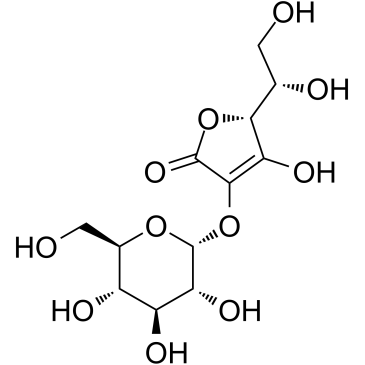Signal transduction pathway for L-ascorbic acid- and L-ascorbic acid 2-glucoside-induced DNA synthesis and cell proliferation in primary cultures of adult rat hepatocytes.
Hajime Moteki, Yuya Shimamura, Mitsutoshi Kimura, Masahiko Ogihara
Index: Eur. J. Pharmacol. 683(1-3) , 276-84, (2012)
Full Text: HTML
Abstract
We examined the effects of L-ascorbic acid and its analogues on DNA synthesis and cell proliferation. We also investigated the signal transduction pathways involved in the induction of mitogenesis by L-ascorbic acid and its analogues using primary cultures of adult rat hepatocytes. Following a 4-h serum-free cultivation, both L-ascorbic acid and its stable analogue, L-ascorbic acid 2-glucoside, time- and dose-dependently stimulated hepatocyte DNA synthesis and cell proliferation, with EC₅₀ values of 6.46×10⁻⁸ M and 3.34×10⁻⁸ M, respectively. Dehydroascorbic acid (10⁻⁶ M-10⁻⁵ M) weakly stimulated hepatocyte mitogenesis, whereas isoascorbic acid (10⁻⁹ M-10⁻⁵ M) had no effect. Hepatocyte mitogenesis induced by L-ascorbic acid or L-ascorbic acid 2-glucoside was dose-dependently abolished by treatment with monoclonal antibodies against insulin-like growth factor (IGF)-I receptor, but not by treatment with monoclonal antibodies against insulin receptor or IGF-II receptor. Western blot analysis showed that both L-ascorbic acid and L-ascorbic acid 2-glucoside significantly stimulated IFG-I receptor tyrosine kinase activity within 3 min, and mitogen-activated protein (MAP) kinase activity within 5 min. These results demonstrate that both L-ascorbic acid and L-ascorbic acid 2-glucoside induce DNA synthesis and cell proliferation in primary cultures of adult rat hepatocytes by interacting with the IGF-I receptor site and by activating the receptor tyrosine kinase/MAP kinase pathway.Copyright © 2012 Elsevier B.V. All rights reserved.
Related Compounds
| Structure | Name/CAS No. | Molecular Formula | Articles |
|---|---|---|---|
 |
Ascorbyl Glucoside
CAS:129499-78-1 |
C12H18O11 |
|
Functions, applications and production of 2-O-D-glucopyranos...
2012-07-01 [Appl. Microbiol. Biotechnol. 95(2) , 313-20, (2012)] |
|
Systems engineering of tyrosine 195, tyrosine 260, and gluta...
2013-01-01 [Appl. Environ. Microbiol. 79(2) , 672-7, (2013)] |
|
Evaluation of the antioxidative capability of commonly used ...
2012-07-02 [J. Photochem. Photobiol. B, Biol. 112 , 7-15, (2012)] |
|
Regioselective monoacylation of 2-O-α-D-glucopyranosyl-L-asc...
2011-11-08 [Carbohydr. Res. 346(15) , 2511-4, (2011)] |
|
Monoacylation of 2-O-alpha-D-glucopyranosyl-L-ascorbic acid ...
2010-08-16 [Carbohydr. Res. 345(12) , 1658-62, (2010)] |